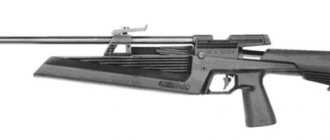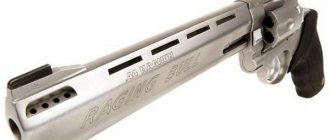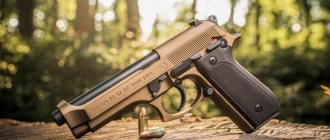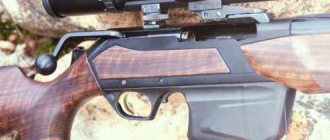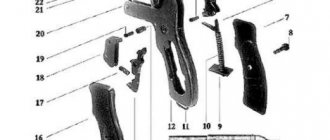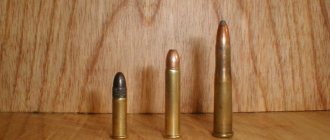Taurus CT9: some like it shorter
Why do people buy 9mm semi-automatic rifles? There are several options: some are thinking about self-defense, others want to save money - after all, the cartridge will cost almost half the price of the most affordable rifle, others thus want to become more “tactical”... You won’t believe it: there will be those who decide to go with this carbine to hunt.
Appearing only at the end of the First World War and not having time to fully demonstrate its capabilities, by the beginning of the Second World War the submachine gun was at the peak of its popularity. It found a place in the weapons systems of many countries; there were dozens of a wide variety of designs in a variety of calibers with a variety of performance characteristics. However, the music did not play for long: with the massive proliferation of weapons chambered for intermediate and low-impulse cartridges, the days of submachine guns seemed to be numbered. Of course: with comparable dimensions, modern versions of compact assault rifles have at least twice the effective firing range, and the total destructive effect of the bullet is incomparably higher.
In detail: incomplete disassembly
Nowadays, the army has a new fetish called PDW (from the English Personal defense weapon - “personal defense weapon”); This ultra-compact weapon uses ammunition whose size, weight and level of recoil when fired are almost no higher than classic pistol ammunition, but has significantly better flatness and increased armor penetration. The PDW concept is most successfully implemented in the Heckler&Koch MP7 and FN P90 models, but that's a completely different story.
Taurus MT9 Gen2 and CT9 Gen2 passed the most difficult tests with honor
From the army to the police
Classic submachine guns not only have not left the scene, but continue to firmly hold their position in the weapons system. It’s just that they were demobilized from the army almost everywhere, but they were accepted into service in the police.
The disadvantage has been turned into an advantage - weak penetration and limited fire efficiency are ideally suited for police functions. Law enforcement officers don't engage in long-range firefights, and their opponents rarely wear body armor (yes, we remember the "Shootout in North Hollywood"). Although there are already special bullets, for which body armor is no longer an insurmountable obstacle. Distances are reduced to a minimum, and the fire contact itself takes place in a densely populated area, where a rifle cartridge bullet, dangerous for many kilometers, can cause trouble. That’s why the “short-shooting” pistol cartridge came in handy. Structurally simple and compact, the submachine gun can, if necessary, create a high density of fire at short distances. The low recoil impulse of the pistol cartridge allows you to more confidently control the weapon during automatic shooting. As a rule, police submachine guns have a caliber identical to a standard pistol, which makes it easier to supply ammunition.
Brazilian way
It is clear that almost none of the “veterans” of World War II have survived to this day. But where have the wonderful “Stans”, “Madsens” and other “Suomi” gone? Where are the national weapons schools? Where is the variety of calibers? Globalization has crushed originality: now muscular clones of the MP-5 and 9-mm conversions of standard assault rifles (like the Steyr AUG Para, Tavor or Colt 635) are driving around in police cars all over the world, and there are only three calibers left for submachine guns in the civilized world: 9x19, .40 S&W and .45 ACP. Although even if we leave aside the Russian Federation or China, which always have their own options, there is at least one more country that has gone its own way in creating a submachine gun.
Taurus MT9 Gen2 is the standard weapon of the Brazilian police.
The Brazilian Forjas Taurus SA, whose history goes back 75 years, is one of the world leaders in the volume of weapons production - more than a million barrels are produced at three factories in Brazil and one in the USA. Most of these weapons are exported to more than 70 countries, with the main trading partner being the United States, where about 50% of the products are sold. Taurus is the main supplier of weapons to the Brazilian army and police. The crime problem in Brazil is one of the main problems of modern society; in terms of murders per capita, this country is almost five times higher than America. There are entire slum areas (called favelas) where the law only applies when there is a riot police presence there; and he, in turn, remains there until the cartridges run out - that is, not for long.
It was for the police in the early 90s of the last century that the MT9 submachine gun was created. Its design is based on the Chilean FAMAE SAF submachine gun, which, in turn, borrowed a lot from the Swiss assault rifle SIG-540, produced in Chile under license. And if the first generation of MT9 and its modification MT40 (differing only in the cartridge used - .40 S&W) can be called a joint creation, then the second generation, presented in 2011 at the IDEX exhibition in Abu Dhabi, is already an independent Brazilian development.
Lower receiver, top view: visible reinforced magazine shaft, trigger trigger, double-sided bolt release release button
Second generation
Work on the second generation Taurus MT9 began in 2009. The creation of a domestic submachine gun for the police was one of the components of large-scale preparations for the 2014 FIFA World Cup. The development team, led by the experienced designer and designer Ricardo Maffazioli, was given the task: the future weapon should have a caliber of 9x19 and .40 S&W; design - based on the simplest and most reliable blowback design; It is mandatory to have a double-sided safety/firing mode selector, as well as a rearrangeable cocking handle that is not connected to the bolt during shooting. For two years the team worked on solving the problem, creating prototypes one after another. The blowback design has been maximally optimized in terms of mass distribution - for maximum stability and balance of the system when firing. Sample tests were carried out with the participation of not only representatives of the police and intelligence services, but also civilian sports shooters. The weapon was originally intended for the police and intelligence services, so the usual tests for the Taurus were tightened as much as possible. The tests included endurance testing, stress tests, drop tests (a weapon with a cartridge in the chamber is dropped onto a concrete floor from a height of 1.5 meters, while the trigger should not fall off the sear), checking operation in conditions of a wide variety of contaminants, testing for stability to aggressive environments, testing the functionality of weapons without lubrication of mechanisms or, conversely, with excessive lubrication, testing the reliability of operation when using non-standard cartridges (with excess pressure, with a reduced load, with a difference in geometry, etc.). Note that the CT9 Gen2 carbine was not the result of the “fencing” of the submachine gun, but was created simultaneously with it by the same team.
Development of the second generation began with computer models
Since 2011, the MT9 Gen2 in .40 S&W has been the standard-issue police weapon in most of Brazil's 26 states. And its civilian brother CT9 Gen2 began its march around the world. The CT9 arrived in Ukraine much later than in the United States and even in Russia, but there is a positive side to this: we got a version that had been tested in the most active arms markets and had the most advanced configuration. By the way, about the package: in the plastic case, in addition to the carbine, there are two magazines with a capacity of 30 rounds, a black fabric belt, a plastic insert in the chamber to indicate discharge and instructions in Russian.
Device
The actual difference between the CT9 G2 carbine and the Taurus SMT9 submachine gun is the longer barrel, fixed stock, and lack of automatic fire capability.
Stress test
The CT9 self-loading carbine uses blowback automatic action. Shooting is carried out from a closed bolt. This scheme has one significant drawback: when the gate is closed, heat dissipation deteriorates. Also, when firing stops, the cartridge remains chambered, which theoretically can lead to self-ignition of the gunpowder from heating the chamber during prolonged tempo shooting. But with our prices for cartridges, one can only dream of such a rate of fire. The list of positive qualities of a circuit with a closed gate is much more extensive. We will name only two of them - the main advantage of them is higher shooting accuracy, since the weapon aimed at the target is not disturbed due to the movement coming off the rear sear of the massive bolt. The second advantage is that the bolt is closed, so no debris will get into the barrel.
The weight of the oxidized bolt is 680 g. Longitudinal grooves are made on its side surfaces - these are dirt removal channels designed to increase the reliability of the carbine in adverse conditions. The drummer is spring-loaded, the extractor is of the “Sakov” type, with a powerful tooth. The reflector is a separate part located in the upper part of the receiver and secured with two Torx screws.
The hammer-type trigger mechanism is made entirely of steel. The trigger force is about 1.5 kg, the trigger is single-stage. The two-position safety box and the slide stop reset button are duplicated on both sides of the lower part of the receiver, which allows the carbine to be used equally comfortably by both right-handed and left-handed people. In the case of a right-handed hold, the safety flag is handled by the thumb of the right hand, the index finger of which remains on the trigger at this time, and the bolt stop is controlled by the thumb of the left hand, holding the carbine by the tide of the magazine shaft. In a word, everything is in order with ergonomics.
The 10.5″ (27 cm) cold forged barrel has six right-hand rifling at 1:9″ pitches, is free-floating and has a flash hider mounted on M14x1 threads. The diameter of the barrel at the muzzle is 16 mm. The minimum guaranteed barrel life is 10,000 shots, but the company has the MT9 Gen2, which has already fired almost 100,000.
Stock with pistol grip and lower receiver. In an alcove behind the mine
the magazine release button is visible
Receiver
The receiver consists of two halves - upper and lower receivers. The upper one is made of aluminum alloy by casting with subsequent processing, the lower one is made of polymer material with oxidized metal inserts. Located in the front part of the lower receiver, the inclined magazine shaft is grooved in the front part for easy holding. At the top of the aluminum receiver there is an integral Weaver/Picatinny rail, and inside there are guides for the shutter. The upper receiver with the bar is anodized. The halves of the receiver are connected by two pins (pins) - according to the principle of rifles of the AR-15 family. For partial disassembly, you need to use the tip of the bullet to squeeze out the pin in the rear of the receiver and break the carbine around the front pin.
Shop
The supplied steel double-row magazines have a capacity of 30 rounds (10 with the limiter installed). On the right side there are windows for monitoring the remaining cartridges in the magazine, designed to indicate the presence of 10, 20 and 30 cartridges. The weight of an empty magazine is 180 g. The feeder is made of yellow plastic, it is clearly visible in the extraction window - and this makes it much easier to inspect the weapon for unloading. After the cartridges are used up, the carbine locks onto the bolt stop. The magazine is inserted in an upward motion without turning further; the click of the latch is quite loud. The large release key, controlled by the thumb of the holding hand, is located behind the magazine; it is recessed into the hollow protrusion of the lower receiver. This solution reliably protects the lock key from accidental pressing.
Upper receiver: assorted Weaver/Picatinny rails
Lodge
The stock and fore-end are made of impact-resistant polymer. The frame stock, evoking Swedish reminiscences, is combined with a pistol grip. The butt plate is plastic, with large corrugation, to improve the fixation of the butt when resting on the shoulder. The length of the trigger (that is, the distance from the middle of the butt plate to the trigger) is 380 mm, which is significantly longer than, for example, a standard AK. During our tests, we asked people with a height of 170 to 190 cm to evaluate the comfort of the stock - all of them were quite satisfied. There is a polymer damper in the front wall of the butt to soften the shock of the bolt in the rearmost position. There is a hole in the butt bridge into which you can insert a pin when disassembling the weapon - this solution will help you avoid losing a small part when servicing the carbine in the field. The 30-degree angled pistol grip has a finger grip for a secure grip.
On the lower part of the forend, a polymer Weaver/Picatinny RAS (Rail Accessory System) strip 119 mm long with 11 slots for placing additional equipment (front handle, flashlight, target designator, etc.) is installed on two Torx screws. The same bar is located on the right side of the forend. If desired, the owner can move it to the left side - there are also mounting holes there.
The bolt with the firing pin removed. Extractor tooth visible
Sights
The standard sighting devices are an adjustable rear sight mounted on a Picatinny rail and a non-adjustable front sight with a white dot protected by a front sight. Both the front and rear sights are made of polymer. The rear sight is reversible and has two positions - a diopter and a slot with a white border. Note that due to the wide front sight, aiming at small targets is difficult. But submachine guns are not designed for long distances; Their task is to shoot at close targets, most often offhand, so a large front sight comes in handy here. In addition, standard sighting devices can be easily removed, and an optical sight or collimator can be installed in their place.
Cartridge 9x21
Carbines chambered for the 9x19 cartridge are produced by many weapons companies. At the same time, the status of weapons chambered for these cartridges is ambiguous. Most of these cartridges are pistol cartridges, and weapons chambered for pistol cartridges are generally not available to civilians in most countries. In other countries - for example, in Italy, Mexico and France - civilians are not able to purchase weapons only in calibers that are not used by the army and police. These restrictions at one time gave rise to the 9x21 cartridge, which was intended to become a civilian analogue of the service 9x19. Moreover, in some countries the 9x21 is classified not as a pistol cartridge, but as a carbine cartridge. Our test used Sellier & Bellot cartridges with a 124 grain (8.03 g) Soft Point semi-jacketed bullet and an FMJ jacket of the same weight. The initial speed of the SP bullet is 365 m/s, the initial energy is 533 J, for the FMJ these figures are 362 m/s and 524 J, respectively.
Magazine capacity of 30 rounds. Pay attention to the windows to control the number of cartridges
Scope of application
So, how can this carbine be in demand?
He is classified as a hunting dog, and we will be the first to throw a stone at anyone who says that hunting with him is impossible. You can hunt, you just need to carefully choose the object of hunting and take a sober approach to assessing effective distances. In our opinion, the main areas of use for the Taurus CT9 G2 will be self-defense and recreational shooting. This is a compact and fairly accurate carbine, thanks to a large number of Picatinny rails, adaptable to a wide variety of tactical situations. Entertaining shooting is his element; The Taurus CT9 G2 has good ergonomics coupled with a low recoil impulse, and the price of its cartridge is almost half the price of the most affordable .223. 9x19 (left) and 9x21.
There is a noticeable difference in the length of the cartridge case. The shooting was carried out in a closed shooting range from a sitting position with a rest, shooting was carried out at a distance of 50 m in series of 5 shots. In order to minimize errors when aiming, an optical sight with a built-in Nikon L700 2.5-10x40M R4B rangefinder was installed on the carbine. Its German #4 style reticle made it easy to snap to the number markings on a standard #4 chest target.
The long, wide polymer trigger has a slight curve and is positioned toward the rear of the trigger guard, leaving more than enough room in the trigger guard for gloved operation. The single-stage trigger action may not be ideal for those used to rifle triggers, but it's not bad at all. There is practically no recoil when firing. The extraction of spent cartridges is clear and energetic, the cartridge flies out at 3 o'clock. Holding the weapon by the magazine shaft is very comfortable.
One of the questions that concerns those who are still going hunting with the Taurus CT9: are the noses of semi-jacketed bullets deformed when fed? We specifically experimented and responsibly declare: they are not deformed.
The diameter of the best group of five hits for the cartridge with the FMJ bullet was 90 mm, while the SP half-shell unexpectedly fell within 34 mm. We believe that such accuracy is quite sufficient to hit a biological target at a distance of up to 150 m. We do not encourage shooting at longer distances from weapons chambered for such a cartridge, since the trajectory of the bullet requires corrections when aiming - and when shooting from the Taurus CT9, you don’t have to think about corrections it turns out. It’s impossible to think at all during this shooting, because you completely surrender to the feeling, which cannot be described except by the word fun (English - joy, pleasure). This is real fun-shooting!
The culmination was a quick series (10 shots in 9 seconds) from a standing position at the same 50 meters. The diameter of the resulting group was 195 mm, located in the central region of the chest figure. Just in case, we will also provide energy data: at 50 meters, the bullet of the cartridge that we used to shoot from the Taurus CT9 has an energy of 397 J - which is 100 J higher than that of the bullet of the 9x18 PM cartridge when leaving the barrel of a Makarov pistol. An encouraging result from the point of view of self-defense use!
Text: Dmitry Dzhulay, photo: Taras Oleynik
TAURUS CT9 G2 CARBINE Ready for battle
The TAURUS CT9 G2 self-loading carbine for pistol ammunition 9x19 LUGER is the latest model from TAURUS. The carbine was first presented at the ShotShow 2011 exhibition (USA).
Something strange and incredible happened in Russia. In the gun store you can buy the legendary 9x19 LUGER cartridges. The only caveat is that before this you need to buy a rifle chambered for this cartridge. In general, it is no more difficult than buying any rifled weapon. It is enough to have five years of experience in owning a smooth-bore weapon, be a member of a hunting society, obtain a medical certificate, take training courses and pay receipts.
The rifle we got our hands on is called the TAURUS CT9 G2. Here's what the manufacturer says about it. Self-loading carbine TAURUS CT9 G2 for pistol ammunition 9x19 LUGER, the latest model from TAURUS. The carbine was first presented at the ShotShow 2011 exhibition (USA). In addition to the CT9 G2, the TAURUS product line will include the CT40 G2 and CT45 G2 models for .40 S&W and .45 AUTO pistol ammunition, respectively.
The barrel of the CT9 G2 carbine has a length of 407 mm and is capable of withstanding the pressure of reinforced +P (Plus Power) ammunition. A thick-walled barrel with a massive chamber improves heat transfer, which has a positive effect on the repeatability of STP during intense shooting. The carabiner is 31.5 inches (800.1 mm) long. The CT9 G2 has a permanent frame stock integrated with a fire control handle. The stock, fore-end and trigger guard with magazine neck extender are made of impact-resistant polymer.
A RAS (Rail Accessory System) Picatinny rail is mounted in the base on the lower part of the forend for installing additional equipment (front handle, flashlight, laser pointer, etc.). There are holes on the sides of the forend for additional RAS rails. The upper part of the receiver (Upper Receiver) is made of aluminum alloy using high-precision casting with subsequent processing. Along the entire length, the upper part of the receiver has a continuous Picatinny rail RIS (Rail Interface System), made according to the MilSpec 1913 standard, which allows you to install all types of optical, collimator and night sights on it.
Standard sights consist of a front sight and a reversible diopter rear sight. They are installed directly on the RIS bar and, if necessary, can be moved along its entire length or completely removed. The Lower Receiver is made of polymer molded around a steel chassis. The CT9 G2 carbine is a self-loading weapon that fires from a closed bolt.
The trigger mechanism is hammer-type, made entirely of steel. The safety box is located on both sides of the lower part of the receiver, which allows the carbine to be used equally conveniently by left-handed shooters. The shutter release button is also duplicated on the left side. Partial disassembly of the carbine is carried out without tools, by squeezing out the spring pin in the rear part of the receiver (to avoid loss, there is a hole in the butt to place the pin while servicing the carbine).
To increase the reliability of the carbine when used in unfavorable conditions (dirt, sand, snow, etc.), the moving parts and rubbing pairs have dirt drainage channels. To resist corrosion, the upper receiver and Picatinny rail, made of aluminum alloy, are anodized, and all steel parts of the lower receiver are oxidized. In fact, the CT9 G2 carbine is the civilian version of the new Taurus SMT9 submachine gun in 9*19 Luger and SMT40 in 40SW caliber.
The differences between the civilian version of the carbine include a total length of over 800 mm, an elongated barrel, a non-folding stock, a limited magazine capacity and the inability to fire automatically. However, the CT9 G2 retains the reliability and high operational durability of a submachine gun for the army and law enforcement. We were able to test the rifle at one of the Moscow shooting ranges. There were several rifles, and even more magazines for them.
It is a great pleasure to equip magazines with pistol cartridges. Of course, it would be great to load 30 rounds of ammunition into the magazine, but the law is the law. ONLY 10. Therefore, I equipped 6 stores at once. Shooting was carried out at a distance of 50 meters, at pistol target #4. What conclusions were drawn?
Firstly, there is no recoil at all. Therefore, the first 60 shots were fired within five minutes. Reloading followed. No one limited the ammunition, so more than 400 shots were fired. We fired 9x19 cartridges produced by BARNAUL and TULAMMO. Secondly, the shot is much quieter than from a CZ-75 pistol. The magazine is inserted with considerable effort. It's not for everyone, but I didn't really like it. The descent is relatively soft. But not ideal. There was not a single delay during shooting due to the fault of weapons or ammunition.
Unfortunately, it was not possible to disassemble the carbine and look at the insides after 400 shots, I wonder if the mechanism was very dirty? The sights are convenient, but I had a desire to remove them and install an AIMPOINT Micro collemator. The lower weaver requires a handle, since holding the forend with the weaver bar with your hand is not very convenient. Accuracy at 50 meters is sufficient. A long distance was not available to us. Also made 5 control shots at the target. The result was a group of about 8 centimeters.
To summarize, I would like to say the following. This carbine is a serious tool and the first sign on the Russian market for serious ammunition. The tuning capabilities are impressive. You can attach everything to a weapon, from various types of optics to grips, laser designators, tactical flashlights and other bells and whistles. I wouldn’t take this carbine for hunting, but I’d be happy to hang it on my back while riding a snowmobile or ATV, put it in a boat or in the back seat of a car on a long journey.
Text: Modest Kurkov Photo: Mikhail Mokin
